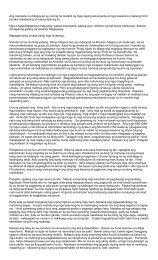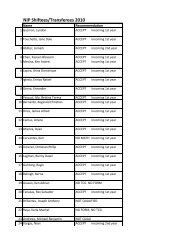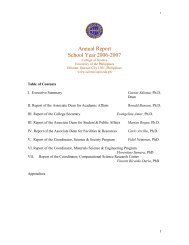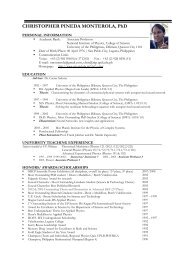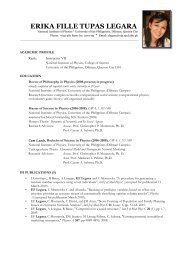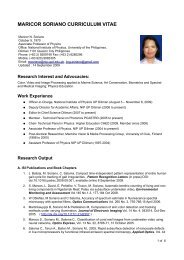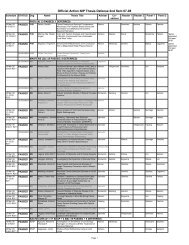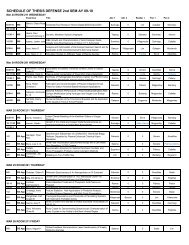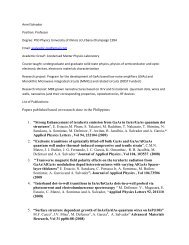NIP REPORT January 2006- May 2007 - The UP College of Science ...
NIP REPORT January 2006- May 2007 - The UP College of Science ...
NIP REPORT January 2006- May 2007 - The UP College of Science ...
Create successful ePaper yourself
Turn your PDF publications into a flip-book with our unique Google optimized e-Paper software.
Importance <strong>of</strong> the project<br />
<strong>The</strong> project is timely because it addresses a wide ranging topic that needs resolution, and whose<br />
resolutions have immediate theoretical and practical consequences. Moreover, the availability <strong>of</strong><br />
technology needed in confirming our theory makes it even more timely. Its relevance ranges<br />
from foundational issues like quantum measurement theory and interpretations <strong>of</strong> quantum<br />
mechanics to technologically material issues like data analysis for ultracold atom time <strong>of</strong> fight<br />
experiments and temporal aspects <strong>of</strong> quantum tunneling.<br />
Relevance in quantum measurement theory: <strong>The</strong> eigenfunctions <strong>of</strong> the confined time <strong>of</strong> arrival<br />
operators evolve such that the probability <strong>of</strong> finding the quantum particle at the arrival point is<br />
maximum at their corresponding eigenvalues. In the limit <strong>of</strong> infinite confining length, the<br />
eigenfunctions evolve to a Dirac delta at the arrival point at their eigenvalues. This dynamical<br />
behavior <strong>of</strong>fers a quantum mechanical picture <strong>of</strong> the arrival <strong>of</strong> a quantum particle. And this has a<br />
direct bearing in the long standing quantum measurement problem. In standard quantum<br />
mechanics, there are two known dynamics <strong>of</strong> a quantum system: <strong>The</strong> continuous unitary<br />
evolution <strong>of</strong> the system under Schroedinger's equation, and the discontinuous non-unitary<br />
evolution during quantum measurements. <strong>The</strong> discontinuity during quantum measurements is<br />
known as wavefunction collapse and it has two distinct aspects: discontinuity in time or quantum<br />
jump, and discontinuity in space or the appearance <strong>of</strong> particle. <strong>The</strong> quantum jump occurs when<br />
measurement at some instant <strong>of</strong> time projects the initial state to another state. <strong>The</strong> particle<br />
appears when the initial state spontaneously collapses to a state <strong>of</strong> point support during position<br />
measurement, such as the scintillation on a screen. However, standard quantum mechanics has so<br />
far failed to provide a consistent mechanism on the emergence <strong>of</strong> these discontinuities from its<br />
own premises, leaving wavefunction collapse an ad hoc hypothesis. This is the well-known<br />
quantum measurement problem (QMP). <strong>The</strong> QMP has been the source <strong>of</strong> endless debate on the<br />
proper accounting <strong>of</strong> quantum mechanics. Existing different approaches to and interpretation <strong>of</strong><br />
quantum mechanics have been developed to address these discontinuities. Our quantum theory <strong>of</strong><br />
spacetime arrival, however, provides a framework in which the appearance <strong>of</strong> particles is not a<br />
distinct discontinuity but in fact a consequence <strong>of</strong> the combined effect <strong>of</strong> quantum jump and<br />
unitary Schroedinger evolution, reducing the QMP to half.<br />
Relevance in interpretation <strong>of</strong> quantum mechanics: Because <strong>of</strong> our theory's implications on the<br />
appearance <strong>of</strong> particles, it has heavy impact on the interpretation <strong>of</strong> quantum mechanics. <strong>The</strong><br />
majority <strong>of</strong> the proposed alternative interpretations and formulations <strong>of</strong> quantum mechanics have<br />
been conjured to address, in particular, the appearance <strong>of</strong> the particle, for example, Bohmian<br />
mechanics, non-linear quantum mechanics and spontaneous localization theory. In these<br />
alternative formulations, the basic Schroedinger equation is supplemented with additional<br />
features outside standard quantum mechanics to allow for the emergence <strong>of</strong> particles. <strong>The</strong> advent<br />
<strong>of</strong> our theory raises issues against these formulations. Of importance is our theory giving<br />
predictions that is distinct from the predictions <strong>of</strong> these alternative formulations <strong>of</strong> quantum<br />
mechanics. Our theory then can play a decisive role in discriminating alternative formulations <strong>of</strong><br />
quantum mechanics from the standard formulation. However, our theory may potentially<br />
disagree with the theory <strong>of</strong> decoherence in the description <strong>of</strong> particles. Decoherence theory<br />
81



